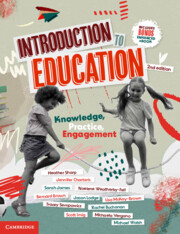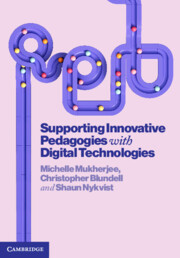Refine search
Actions for selected content:
48 results

Introduction to Education
- Knowledge, Practice, Engagement
-
- Published online:
- 14 June 2025
- Print publication:
- 02 June 2025
-
- Textbook
- Export citation
Chapter 10 - What is in a teacher’s toolkit?
- from Part 2 - Understanding learning and understanding teaching
-
-
- Book:
- Introduction to Education
- Published online:
- 14 June 2025
- Print publication:
- 02 June 2025, pp 240-286
-
- Chapter
- Export citation
9 - ‘Receiving Rich Gifts’: Negotiating Power in the Metrical Paratexts of the Vossianus Gr. Q1
- from Part III - Poetry, Patronage and Power
-
- Book:
- Poetry in Byzantine Literature and Society (1081-1204)
- Published online:
- 17 October 2024
- Print publication:
- 31 October 2024, pp 225-255
-
- Chapter
- Export citation

Supporting Innovative Pedagogies with Digital Technologies
-
- Published online:
- 24 July 2024
- Print publication:
- 13 June 2024
-
- Textbook
- Export citation
Chapter 11 - Your role and responsibilities as an educator in a digital world
- from Part 3 - Professional responsibilities for teaching with digital technologies
-
- Book:
- Supporting Innovative Pedagogies with Digital Technologies
- Published online:
- 24 July 2024
- Print publication:
- 13 June 2024, pp 193-210
-
- Chapter
- Export citation
Chapter 1 - Why use digital technologies in learning and teaching?
- from Part 1 - Understanding learning and teaching with digital technologies
-
- Book:
- Supporting Innovative Pedagogies with Digital Technologies
- Published online:
- 24 July 2024
- Print publication:
- 13 June 2024, pp 9-19
-
- Chapter
- Export citation
Chapter 10 - Explore interests via co- and extracurricular activities
- from Part 2 - Designing and enacting learning and teaching with digital technologies
-
- Book:
- Supporting Innovative Pedagogies with Digital Technologies
- Published online:
- 24 July 2024
- Print publication:
- 13 June 2024, pp 177-190
-
- Chapter
- Export citation
Chapter 5 - Using digital technologies to learn information knowledge
- from Part 2 - Designing and enacting learning and teaching with digital technologies
-
- Book:
- Supporting Innovative Pedagogies with Digital Technologies
- Published online:
- 24 July 2024
- Print publication:
- 13 June 2024, pp 76-97
-
- Chapter
- Export citation
Chapter 7 - Using digital technologies to learn with our bodies
- from Part 2 - Designing and enacting learning and teaching with digital technologies
-
- Book:
- Supporting Innovative Pedagogies with Digital Technologies
- Published online:
- 24 July 2024
- Print publication:
- 13 June 2024, pp 119-133
-
- Chapter
- Export citation
Chapter 4 - Learning and teaching environments
- from Part 2 - Designing and enacting learning and teaching with digital technologies
-
- Book:
- Supporting Innovative Pedagogies with Digital Technologies
- Published online:
- 24 July 2024
- Print publication:
- 13 June 2024, pp 61-75
-
- Chapter
- Export citation
Chapter 3 - Models and frameworks for understanding digital technologies in learning environments
- from Part 1 - Understanding learning and teaching with digital technologies
-
- Book:
- Supporting Innovative Pedagogies with Digital Technologies
- Published online:
- 24 July 2024
- Print publication:
- 13 June 2024, pp 34-58
-
- Chapter
- Export citation
Chapter 12 - Your role as a learner and innovator
- from Part 3 - Professional responsibilities for teaching with digital technologies
-
- Book:
- Supporting Innovative Pedagogies with Digital Technologies
- Published online:
- 24 July 2024
- Print publication:
- 13 June 2024, pp 211-234
-
- Chapter
- Export citation
Chapter 6 - Using digital technologies to learn mental procedures
- from Part 2 - Designing and enacting learning and teaching with digital technologies
-
- Book:
- Supporting Innovative Pedagogies with Digital Technologies
- Published online:
- 24 July 2024
- Print publication:
- 13 June 2024, pp 98-118
-
- Chapter
- Export citation
Chapter 8 - Collecting and assessing evidence of learning
- from Part 2 - Designing and enacting learning and teaching with digital technologies
-
- Book:
- Supporting Innovative Pedagogies with Digital Technologies
- Published online:
- 24 July 2024
- Print publication:
- 13 June 2024, pp 134-156
-
- Chapter
- Export citation
Chapter 9 - Supporting students’ citizenship and wellbeing in a digital world
- from Part 2 - Designing and enacting learning and teaching with digital technologies
-
- Book:
- Supporting Innovative Pedagogies with Digital Technologies
- Published online:
- 24 July 2024
- Print publication:
- 13 June 2024, pp 157-176
-
- Chapter
- Export citation
6 - Emoji in General Education
-
- Book:
- Emoji in Higher Education
- Published online:
- 30 May 2024
- Print publication:
- 06 June 2024, pp 137-158
-
- Chapter
- Export citation
12 - Schools and Offices
- from Part II - Essential Signs
-
- Book:
- Chinese Signs
- Published online:
- 29 February 2024
- Print publication:
- 07 March 2024, pp 109-117
-
- Chapter
- Export citation
Chapter 7 - Theories of Anthologizing and Decolonization
- from Part II - Methodologies
-
-
- Book:
- Decolonizing the English Literary Curriculum
- Published online:
- 02 November 2023
- Print publication:
- 09 November 2023, pp 149-166
-
- Chapter
-
- You have access
- Open access
- HTML
- Export citation
Teaching Health Law
-
- Journal:
- Journal of Law, Medicine & Ethics / Volume 51 / Issue 3 / Fall 2023
- Published online by Cambridge University Press:
- 13 December 2023, pp. 698-702
- Print publication:
- Fall 2023
-
- Article
-
- You have access
- Open access
- HTML
- Export citation
2 - Communicative Interaction in the Foreign Language Classroom
-
- Book:
- Expressions, Speech Acts and Discourse
- Published online:
- 08 June 2023
- Print publication:
- 22 June 2023, pp 7-22
-
- Chapter
- Export citation
